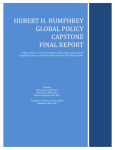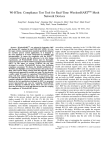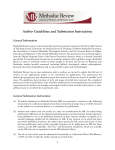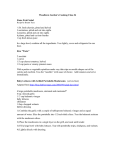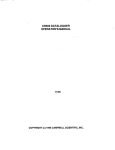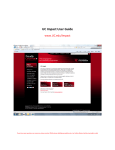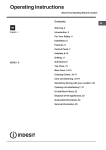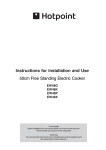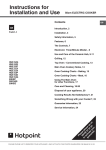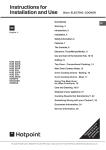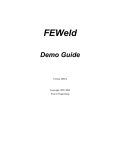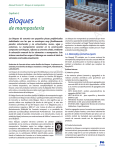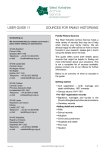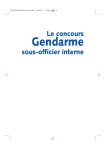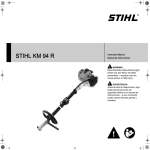Download Early Response Team - Middletown United Methodist Church
Transcript
Early Response Team Providing a Caring Christian Presence in the Aftermath of Disaster A Collaborative Effort by © 2009 United Methodist Committee on Relief General Board of Global Ministries The United Methodist Church TABLE OF CONTENTS 1 2 3 4 7 9 11 13 15 18 21 25 27 31 33 35 A-1 A-2 A-6 A-14 A-15 A-17 A-18 A-19 A-20 A-30 A-32 A-34 B-1 B-2 B-3 B-4 B-5 B-6 B-7 B-8 B-9 B-13 Introduction UMVIM: Why We Are Volunteers UMCOR: Guiding Values for Humanitarian Relief Work Covenant of UMCOR and UMVIM in US Disaster Response When Why What Working with Survivors Seven Important Things to Know About Disaster Spiritual and Emotional Care Organizational Structure for Relief Stage (chart) Who Team Safety ERT Protocols Safe Sanctuaries Equipping an ERT Chainsaw Safety and Operations - Course Requirements Outline Appendix and Resource Guide Glossary of Disater-Related Acronyms and Terms Cleaning Out Damaged Homes Safety Suggestions for Extension Cords Ladder Safety Safety First Operating the Saw Limbing and Crosscutting How to Install Self-Help Tarp Disaster ERT Equipment (list) Equipment Alphabatized (list) The 5 UMC Jurisdictions Forms Suggested Questions for Volunteer Group Debriefing Participant Liability Release Form Statement of Understanding for Access to Property GBGM Accidental Insurance Application Disaster Preparedeness ERT Information Application Medical Information for Individual Volunteers Online Resources ERT Basic Test UMCOR ERT Training Participation Evaluation NOTES INTRODUCTION The Mission of an Early Response Team is to provide a caring Christian presence in the aftermath of a disaster. This team is neither a first response group of emergency workers nor a recovery rebuild or repair team; rather it fills a specific need in the early days after a disaster to establish the presence of the church. While there are specific tasks assigned to early response teams, no task is more important than the people it serves. Mission The mission of an Early Response team is to provide a caring Christian presence in the aftermath of disaster. History Early Response Teams were first created by the United Methodist Church in the mid 1990s. It began, as it remains today, as a cooperative effort between the United Methodist Committee On Relief and the United Methodist Volunteers in Mission. In early 2007, a covenant was formed between the two groups and a new protocol was established. The covenant is on the following pages and the protocol is included in the body of this manual. It is also important to understand that ER Teams are trained primarily to respond within their own community. Your team does not need an invitation to respond in your own community or in your own Methodist district. To travel to another district, conference, or jurisdiction, requires the invitation by the affected community. (For information on jurisdictions and conferences check the web www.umc.org/directory) • 1969 Hurricane Camille • 1990’s creation of ERT concept for UMC • 2007 New Covenant Agreement Who are UMCOR and UMVIM? • Guiding Values for Humanitarian Relief Work… • Why We Are Volunteers… Now you know who we are…who are you? Each individual annual conference must decide how and when they will use ERT’s and how they fit into the conference disaster response plan. The manual is not designed to cover every possible situation nor every possible reaction. Rather, this class aims to equip persons with the skills and information to make appropriate responses to any relief situation. Thanks to Fred Toland and Gordon Knuckey for creating the original ERT guidelines. This document was revised in 2009 by UMCOR Consultants Barbara Tripp, Rick Hill, and Christy Smith along with input from the Five Jurisdictional UMVIM Coordinators. Special acknowledgement to Alexandra Browning and Jeremy Wicks for the graphic design of the manual. 1 UNITED METHODIST VOLUNTEERS IN MISSION WHY WE ARE VOLUNTEERS The understanding that we are called and that we are sent is at the foundation of our faith. The scriptures are full of stories of persons who responded to a call and were sent on mission for God. Jesus spent his ministry calling persons and sending them on God’s mission. Jesus summed up the Christian lifestyle in a simple formula: “Love the Lord your God with all your heart, and with all your soul, and with all your mind, and with all your strength” and “Love your neighbor as yourself.” Putting our faith into action is at the very heart of our Christian calling. The New Testament instructs those who would be followers of Jesus to feed the hungry, clothe the naked, give shelter to the homeless, heal the sick, care for the widows, and nurture the children. Through volunteers in mission, every person in the church has the opportunity to serve and to live their lives more faithfully. And when we reach out and use what God has given us in the service of others, we have life-transforming experiences. We are told that Jesus came in order that we might be able to tear down walls of hostility that divide and to build bridges of understanding. We are called, wherever we are in the world, to love all of God’s creation and to demonstrate that love with action. UMVIM exists to promote, encourage, and enable Christians to exemplify “Christian Love In Action” through short-term mission service in the United States and abroad UMVIM provides opportunities for service by developing and nurturing relationships with domestic and international leaders. We continually nurture our contacts with these leaders to respond to the needs of local communities and to provide comprehensive project information. Our office strives to connect volunteers’ talents to suitable projects for effective service. UMVIM also promotes and encourages mission through our email newsletter, the UPDATE, our printed literature, and our Web site. These tools present mission to our current community and potential volunteers, as well as to other United Methodists and Christians. We also provide comprehensive training programs for individuals and team leaders to help them prepare themselves and their teams for the mission field. 2 UNITED METHODIST COMMITTEE ON RELIEF GUIDING VALUES FOR HUMANITARIAN RELIEF WORK UMCOR is the humanitarian relief and development agency of the United Methodist Church. Compelled by Christ, UMCOR responds to natural or human-made disasters- those interruptions of such magnitude that they overwhelm a community’s ability to recover on its own. • UMCOR’s mission is to alleviate human suffering. We provide practical, proactive support to the most vulnerable survivors of chronic or temporary emergencies due to natural or civil causes. • UMCOR honors cultural differences. We deliver aid to people without regard to race, reli gion, politics, or gender. We seek input from local communities in identifying needs. • All people have God-given dignity and worth. The most essential partner in UMCOR’s work is the beneficiary, the ultimate end-user of our service. There are no “victims” in our vocabu lary. There are only survivors whose courage, along with a humanitarian helping hand, can transform communities. • UMCOR always works with partners—usually in local settings. Civic organizations, faith communities, school leaders and other local resources are great assets to sustainable re covery and development, particularly after massive traumatic events. They exist close to the beneficiary and will continue to serve as positive influences in the community after UMCOR’s work is complete. • UMCOR is a good steward of our gifts and grants. Private donors can designate their gifts to our programs with the assurance that 100 percent is spent on the programs. The 8.5 million members of the United Methodist Church assure our ability to guarantee this through undesignated giving that underwrites our general administrative expenses. • UMCOR avoids tying the promise of its relief and development activity to any religious or political viewpoint. • UMCOR welcomes the good efforts of countless individuals and churches who support us through gifts and prayers and service. We incorporate volunteer action everywhere we can and ask our supporters to accept that sometimes it is not appropriate. We appeal to all volunteers to keep learning as their first objective so that the consequences of their service may become a true benefit. 3 COVENANT OF UMCOR AND UMVIM IN U.S. DISASTER RESPONSE Covenant Preamble As people called by God to be servant leaders of the church in US Disaster Response, we acknowledge the profound mystery of pain, suffering and death in the world. With Christians throughout the ages we pray for the coming of God’s reign in all of Creation (Matthew 5:1-20, 6:9-13, Luke 11: 1-13). We live in active expectancy of the time when there will be no more sound of weeping, nor cries of distress, when all children shall live beyond infancy and all old people shall live out their days, when justice shall roll down like waters, and righteousness like an ever-flowing stream, and when all the earth shall be as full of the knowledge of God as the waters cover the sea (Isaiah 11:9, 65:20, Amos 5:24). Meanwhile, we give thanks that God has raised up UMCOR and UMVIM to coordinate and strengthen the servant leadership of the church for US Disaster Response and recognize the unique and complementary gifts and graces of these two programs. We affirm that by working collaboratively in the oneness of the Body of Christ they are much more effective and responsive than either can be separately. Since both UMCOR and UMVIM have the same goal of serving the most vulnerable people affected by disaster, we enter into this covenant in a spirit of cooperation and humility, seeking to be faithful disciples of Jesus Christ as we reach out to those in need. Nature and Purpose of the Covenant The ministry of all Christians consists of service for the mission of God in the world. The mission of God is best expressed in the prayer that Jesus taught his first disciples: Thy kingdom come; thy will be done, on earth as in heaven. All Christians, therefore, are to live in active expectancy: faithful in service of God and their neighbor; faithful in waiting for the fulfillment of God’s universal love, justice, and peace on earth as in heaven. Pending this time of fulfillment, the ministry of all Christians is shaped by the teachings of Jesus. The handing on of these teachings is entrusted to leaders who are gifted and called by God to appointed offices in the church: some apostles, some prophets, some evangelists, some pastors and teachers, to equip the saints for the work of ministry, for building up the body of Christ (Ephesians 4:11-12). For these persons to lead the church effectively, they must embody the teachings of Jesus in servant ministry and servant leadership. Through these ministries and leadership, congregations of the church are faithfully engaged in the forming of Christian disciples and vitally involved in the mission of God in the world. The United Methodist tradition has recognized that laypersons as well as ordained persons are gifted and called by God to lead the church. The servant leadership of these persons is essential to the mission and ministry of congregations. 4 The privilege of servant leadership in the church is the call to share in the preparation of congregations and the whole church for the mission of God in the world. The obligation of servant leadership is the forming of Christian disciples in the covenant community of the congregation. This involves discerning and nurturing the spiritual relationship with God that is the privilege of servant ministers. It also involves instructing and guiding Christian disciples in their witness to Jesus Christ in the world through acts of worship, devotion, compassion, and justice, under the guidance of the Holy Spirit. John Wesley described this as “watching over one another in love.” The Book of Discipline of The United Methodist Church (2004): 131, 132, 136, pp. 90-92. The Covenant With the grace of God and the support of my colleagues in UMCOR and UMVIM, I will: Treat all people involved in a disaster as children of God and worthy of my respect. Regard the collegiality of my fellow workers as a gift from God. Seek to understand and support the variety of roles needed in Disaster Response. Practice good stewardship of my own resources and those of the various disaster volunteer teams, understanding that the funding of the work of UMVIM is the responsibility of the volunteers and that General Advance funds collected by UMCOR for a disaster are distributed within an annual conference by the conference leadership. Ask for the guidance of the Holy Spirit in discerning my own role. Be ready to listen as a ministry of healing. Avoid taking sides in local dynamics that may be exacerbated in a disaster. Hold fast as a disciple of Jesus Christ in the midst of the chaos of disaster. Covenant Commitment Mindful of the suffering of Christ in the suffering of others, I hereby make my commitment, holding myself accountable to my colleagues in Disaster Response and seeking to be mutually supportive at every opportunity. Signed: ________________________________ Date: ________________________________ 5 NOTES 6 WHEN Definition of a Disaster: • A disaster is any specific event which results in overwhelming physical, economic and/or emotional damage to a community. • Results in significant harm to people and property • Disrupts normal pattern of living • Affects individuals, families, neighborhoods, communities, regions... Types of Disasters: • Natural disaster: storms, earthquakes or other natural phenomena • Technical disaster: careless, accidental or intentional abuse of the environment • Economic disaster: sudden loss of income due to shifts in local economy • Civil disaster: riots or civil disturbances in a community • Accident: traffic accidents, fire or other tragic occurrences • Other: pandemics, terrorism, war Phases of a Disaster • Preparation Phase - a time for planning and training, on-going • Response Phase o Emergency- disaster strikes, emergency services and rescue efforts, security o Relief – damage assessment, media coverage and emergency assistance for immediate needs, planning and organizing for long term • Recovery Phase – time of putting things back to “normal,” church be comes more involved o For some it is short term, for others it is a long and complex situation. o Long Term Recovery Committees (LTRC) formed, rebuilding and repairing, o Other Needs Assistance (ONA) • Mitigation- doing what is possible to prevent disaster related damage, reviewing plans and responses for ways to improve Levels of Disasters • Low Level: involves a limited number of households; assistance provided by local churches and districts, with notification to dis- trict superintendent • Medium Level - involves an entire community or several scat tered communities, assistance provided by organizing district response through the district disaster coordinator and district superintendent. • High Level -involves a wide area and requires a massive re sponse by state and national agencies, disaster response com mittee organizes a conference-wide response to the crisis and assists districts and local churches Definition of a Disaster • A disaster is a specific event which results in overwhelming physical, economic and/or emotional damage: • Results in significant harm to people and property • Disrupts normal pattern of living • Overwhelms a community’s ability to respond • May affect individual, family, neighborhood, community, region… Types of Disasters • Natural disasters • Technical disasters • Economic disasters • Civil disasters • Accidents • Other P has es of Dis as ter T he Dis as ter R eadines s and R es pons e C ycle P reparednes s R es pons e Mitigation E mergency & relief R ecovery S hort & long term Levels of a Disasters • Low Level • Medium Level • High Level 7 NOTES 8 WHY Why is there a need for Early Response Teams? 1. It is an opportunity for Christian service for those who want to give of their time. 2. It reassures survivors that the church cares about them. 3. It provides visibility and reassurance for the United Methodist Church. WHY • There are many other organizations involved in the Early Response. Red Cross, Salvation Army, Baptist Men and others. Why does the UMC need to get involved? WHY • Assures survivors the church cares 4. It provides immediate assistance to persons, usually older or disabled, who might not have their support system (family) nearby to assist. 5. It speeds the response to survivors. We, as United Methodists, can be “first in” and “last out.” • Opportunity for service • Immediate assistance • Visibility for hope for the long run 9 NOTES 10 WHAT What do Early Response Teams do? 1. Provide a Christian presence... This does not sound like a task...and is NOT, however it can be the MOST important thing a team can do 2. Take steps to prevent further damage to a family’s personal property (stabilize): • Tarping (see page A-20) • Debris removal, chainsaw work (see pages A-11, A-17 ) • Cleaning out of flooded homes (see page A-6) 3. Teams may be asked to manage donated materials, gather information, or other things as deemed necessary by the com munity 4. Observe survivor’s needs and report these to the local opera tions. 5. Be a part of the caring ministry of “listeners” who will help the survivor begin to heal. WHAT • What do Early Response Teams do? Tasks To Do • Tarp roofs and other openings in homes • Remove debris • Clean out flooded homes- always with permission! • Help with donations management • Help gather information ALWAYS REMEMBER • Teams must be careful NOT to perform work on a home that might jeopardize the survivor’s eligibility for assistance from insurance and/or government agencies • Teams should have written permission to work on people’s homes or to remove personal belongings. It is always best to have the homeowner present when working. (see page B-4) 11 NOTES 12 WORKING WITH SURVIVORS In working with survivors: • A team should always introduce itself first and state what they can do to help • volunteers need to be aware of the following: Working with Survivors • The four tasks in recovery from disaster: – 1. Accept the reality of the situation. [ I can’t believe it happened!] – 2. Experience the pain. It’s OK to hurt. – 3. Accept that a new situation is required. The four tasks in healing from disaster: (all people go through these stages/phases but at different times and at different speeds. Some may even bounce back and forth between stages/phases.) 1. Accept the reality of the situation. [I can’t believe it happened!] 2. Experience the pain. It’s OK to hurt. 3. Accept that a new situation is required. 4. Withdraw the emotional investment in the past and transfer it to the new. – 4. Withdrawing the emotional investment in the past and transferring it to the new. Persons evolve at their own pace and their own way through these steps. Sometimes good intentions will impede that process. “Do no harm!” (Never tell someone not to cry and that everything will be fine!!) Enable recoveryEarly responders will find persons in steps 1 and 2 and often in extreme denial. Sometimes parenting techniques are appropriate when the shock is still in place. Helping the family make small choices might help them get moving towards appropriate action. Sometimes the volunteers will fail to see the shock and expect rationality when it doesn’t exist. Utilize selected forced choices to engage and empower the survivors. Three symptoms of depression Volunteers do not diagnose depression, but may want to refer local officials to a need they sense in a family. 1. Rage 2. Self-pity 3. Sense of loss of control (goes against the American sense of individual freedom) Volunteers MUST sense that they are invading the privacy of the survivors and must respond in a sensitive and caring manner. Often volunteers are meeting their own issues of need through creating artificial dependence by survivors in an inappropriate manner. Early Response Teams can and should be very flexible so that they may be able to respond to any disasters that may occur in the local setting. 13 NOTES 14 SEVEN IMPORTANT THINGS TO KNOW ABOUT DISASTER SPIRITUAL AND EMOTIONAL CARE Tips for Early Response Teams 1. We are guests in the homes of those we help. • We represent Christ’s church and agree to uphold the highest standards of Christian wit- ness and the trust placed in the United Methodist Church. • We behave as we would when invited to anyone’s home. • Remember that cultural and regional customs differ. 2. Be very aware of your own behavior, including the volume of your speech or laughter. • Laughter or loud talk may seem appropriate for the conversations you are having in one part of the site but very inappropriate for others at the site who are hurting and may hear you. 3. Confidentiality is vital to providing a sense of emotional and spiritual safety for survivors. • By agreeing to volunteer on an ERT, you agree to hold the stories about disaster survivors with complete respect for the survivors. While this means that some of the most compel ling stories you encounter must be held in confidence, we must not re-victimize survivors by sharing sensitive information or information that will identify the survivors. An exception may be made if survivors offer specific permission to tell their stories but those stories must still be handled with care. If you tell a story, it is important to state that the survivors asked you to share their story. • It can be very difficult for people to ask for help. You may know people and families that you help. Golden rule: How would you want to be treated if you were asking for help? • You may see behavior that is upsetting or disturbing. At an appropriate time, you may be invited to debrief your experiences in a formal, closed and confidential setting endorsed by your disaster response coordinator. • Important exception: If you encounter someone who threatens to harm themselves or someone else or if you suspect a child, youth or vulnerable adult is being abused or ne glected, you are required to report that to the proper officials. You are still required to refrain from telling this information to others in the community. 4. Don’t make any promises. • Don’t imply any help for survivors unless you know that you personally can provide that help immediately. For example: o You probably do know that you personally and immediately can offer survivors the help you are offering at that moment (muck out, tarping, etc.) or a phone number where they can call for more information. o You probably do not know that you personally and immediately can provide help for survivors such as donations, financial assistance, etc. 5. When in doubt, REFER. • If you are concerned about someone’s behavior or emotional state, contact the mental health resources designated by the conference disaster response officials. Know who you would call before you enter the site. 6. Our ministry here is primarily a ministry of presence. • They will know we are Christians by our love. Religious or faith talk is appropriate if the sur vivor initiates the conversation. • Be aware that you may encounter persons from other faiths. Ask yourself, “Would I want someone of another faith to try to impose their beliefs upon me – especially if I had just been severely traumatized?” 15 NOTES 16 7. Other important “Things to Say” and “Things NOT to say”... • Know that survivors may say things that are disturbing— Our job at this time is to support survivors by listening, accepting intense emotions and validating feelings. (Validating feelings isn’t the same as agreeing with them.) It is not our job to correct or give advice. • Don’t criticize expressions of grief; there is no such thing as an abnormal expression of grief. Survivors may blame themselves when there doesn’t appear to be any reason to do so, but impos ing our values on others by chastising them for the way they feel will not help. 7 Things to Know • • • • • • • We are guests in their home Christian witness by action Confidentiality No promises Refer Ministry of presence Do say/don’t say Things to Say when working with disaster survivors “I am so very sorry” or “I’m so sorry this happened to you.” “My heart is with you” “You will be in my prayers” or “My prayers are with you” “I can see this is hard for you.” “I can see how you might feel that way.” Things NOT to say when working with disaster survivors “It’ll take time, but you’ll get over it.” “Try to be strong for your children.” “It was God’s will.” or “This was meant to happen.” or “There was a rea- son for this.” “You’re lucky it wasn’t worse” or “It could have been worse” or “It was just stuff that you lost.” “You can always have another child.” “You’re still young-- you’ll find someone else.” “This will make you stronger.” Or “Don’t cry.” “Try not to think about it.” “You should hear what happened to me.” “God needed them more than we did.” “It’s time to move on.” “You shouldn’t feel this way.” “I know how you feel.” (Don’t try to tell them that you understand or that you know how they feel. You do not. Even if you have been a disaster victim yourself, each person’s loss is unique.) You are truly God’s instruments of healing and hope. THANK YOU! Rev. Mary E. Hughes Gaudreau, LPC, UMCOR 17 18 MITIGATION Lessen the impact of the next disaster PLANNING Information Gathering Resource Gathering VOLUNTEER MANAGEMENT Early Response Teams Hosting (Assignments) Housing Page A-26 DONATIONS MANAGEMENT Receiving Distribution ADMINISTRATION Financial Record Keeping Computer Support Office Management Team Chaplain Communications PIO Interagency Relations Ecumenical Relations Off Site Coordinator Assistant I.C. CARING MINISTRY Counseling, Debriefing, Training Child, Youth, Adults OPERATIONS CASE MANAGEMENT Supervisor/Executive Case Managers LOGISTICS Supplies & Services Communications (Call Center) Team Safety UMVIM Disaster Vol. Manager Under direction of Jurisdictional VIM UMCOR Staff & Mentors Working under direction of ES-USDR Incident Coordinator Conference DR Coordinator Conference Disaster Response Committee Organizational Structure for Relief Stage Incident Coordination System (ICS) Chart of full-scale Operation 19 NOTES 20 WHO Staffing for Early Response Note: Recognizing the differences in teams from the preceding chart, careful attention should be given here to the titles and responsibilities for early response team members WHO • Team Makeup – The size of the team will vary based on need – 7-14 people per team – Train a LOT more than you need! Team Size The size of the team will vary according to the tasks that need to be performed. WHO UMCOR recommends from 7-14 people on a team. There is a need to recruit at least 3 times as many persons as the size of team you wish to deploy. This will allow the possibility of deploying 2 or 3 teams at once and will help overcome the “Knuckey Rule.” • Team Leader • Assistant Team Leader • Logistics • Base Camp Manager • Equipment Manager • Safety Officer • Listener/ Team recorder The “Knuckey Rule” of disaster response states: At the time of any disaster occurrence, half the people you were counting on for assistance will be unavailable. UMCOR further suggests that in a pool of 30 volunteers that 6 of them are designated as Team Leaders, 3 in Logistics and at least 3 trained in the Ministry of Caring who can function as Listeners. One person should be in charge of equipment maintenance and at least one construction consultant should be available who can be called upon to give advice in plumbing, electrical and structural concerns. Team Functions and Responsibilities: Following are the roles, along with a brief job description for positions UMCOR considers essential to any team: • Team Leader- This is the person in charge of the Early Response Team. This person needs to be a leader and have an over-all understanding of the role of Early Response Teams. This person will relate directly to the conference early response team coordinator. It should be the responsibility of the team leader to direct the work of the team. Team Leader • In charge of the team • Must have overall understanding of the role of ERT • Will work directly with the affected community Ask questions on behalf of team. • Direct all work of the team Assistant Team Leader • Backup for team leader • Assistant Team Leader- This person serves as a back up to the team leader. If it is necessary for the team leader to leave the work site, the assistant then would take over the responsibilities of directing the team. • Logistics- This person is responsible for helping the team find needed supplies and for transportation of the team. The logistics person is also responsible for site safety! This is the person who would check out a site before the team walks into an area to make sure there is no danger to the team where they are to work and that the team has the equipment and ability to do the job assigned. • If Team leader needs to leave site this person will direct the team • Aware of all that’s going on. Logistics • Find the needed supplies • Transport the team • Site Safety 21 NOTES 22 • Base Camp Manager- This person is responsible for food, cooking, water and preparing a place to sleep if it is necessary for the team to spend the night. If the team is totally self-sufficient the BCM shops for food and creates a schedule of who cooks, cleans, etc. so that the load is shared. The BCM works alongside the team during the day. • Equipment Maintenance- This person is responsible for keeping any equipment that the conference may own as a part of an equipment trailer in good working order. This person may be able to do this in off hours or in an “as needed” role but should also accompany the team to a disaster site. • Safety Officer - In addition to the safety functions performed by the logistics person, another member of the team is designated to pay particular attention to the individual team members’ safety. This person checks that the proper personal safety equipment is being used and that all team members are performing at optimal efficiency. When team members start to get tired, it is the responsibility of the safety officer to pull that person out to rest or hydrate as necessary. • Listener/Team recorder - This person is the one person on the team who is designated to be the listener to the survivors. While all members of the team should ALWAYS put people before their task, this person should be a good listener. This person is NOT to provide pastoral care, but should listen to the survivors and get their story. This person will keep the records and forms for the team and be able to refer the survivors’ needs to members of the Conference Disaster Response Team. The following are attributes that are important for any person who would serve on an Early Response Team: • Possess a spiritual commitment • BE A TEAM PLAYER • Understand that people are ALWAYS more important than the task at hand • Be trained prior to assignment • Have a positive attitude • Be observant ... listen • Be understanding of cultural differences • Be understanding of the psychological stress survivors are suffering • Be willing to admit you do not have all the answers • Be realistic about issues and problems that are likely to be faced • Understand that ownership of disaster must stay with the local community The annual conference may wish to take applications for persons wishing to be on the conference early response team. An application is included in the appendix. Base Camp Manager • Food • Cooking • Water • Preparing a place to sleep if needed Equipment Maintenance • Keep all equipment in working order Safety Officer Personal safety of all team members is of utmost importance. This position watches for • proper use of person protective equipment • physical and emotional stamina Listener / Team Recorder • Listen to the survivor • Will keep all records and forms for the team • Relay information to local contact Attributes • • • • • • • • Spiritual Commitment Team player People are more important than task Trained Positive attitude Observant Understanding Ownership is the communities Can Anyone be on a Team? • Must 18 years and older • Must be physically able to do tasks • Must be available! • GPS/3P’s 23 NOTES 24 TEAM SAFETY Personal Safety • Are you in good health? • Do you have the proper clothing? • Are you drinking water? • Are you acting/working safely? • Do NOT attempt tasks you are not qualified or equipped to do • Debrief nightly (see page B-2) • Immunizations (tetanus and hepatitis A and B) Personal Safety Equipment: • Hard hat • Leather/rubber gloves • Safety shoes/ sneakers for roofs/rubber boots • Eye protection • Personal protective equipment (PPE) for chainsaw operators • Ear protection • Breathing protection (proper mask for job) • First Level Trauma Kit (First Aid Kit) Debriefing Self Care: “Self-care is never a selfish act- it is simply good stewardship of the only gift I have, the gift I was put on earth to offer to others. …We do so (not only for ourselves but) for the many others whose lives we touch.” Let Your Life Speak by P.J. Palmer Team Safety • Personal Safety • Personal Safety Equipment • Safe Use of Team Equipment • Additional Trainings Safe Use of Team Equipment: • Ladders (see page A-15) • Generators • Power tools • Extension cords (see page A-14) Recommended Additional Trainings for ER Teams • UMCOR Spiritual and Emotional Care (Call the DC office) • First Aid and CPR • Chainsaw Safety and Operations • UMVIM Team Leadership/Cultural Sensitivity • Children and Youth in Disaster • Red Cross Psychological First Aid • Critical Incident Stress Management (CISM) 25 NOTES 26 EARLY RESPONSE TEAM PROTOCOLS • Early Response Teams are trained by authorized UMCOR trainers only. These trainers will have badges (good for 3 years) issued through the UMCOR Emergency Services Office in Washington, D.C. • Teams properly trained may receive UMCOR national badges, also good for 3 years • Teams will be deployed and coordinated through United Methodist Volunteers in Mission offices. • At many current disaster sites, unaffiliated and uninvited volunteers are not allowed access to the disaster area. Early Response Team Protocols • Trained by UMCOR Authorized Trainers • Deployed and Coordinated through UMVIM • Invitation • 3-Day Limit • Self Sufficient Deployment in the event of a disaster 1. Within an affected annual conference, the Disaster Response Coordinator and Volunteers In Mission personnel will determine the need for ER trained teams. 2. The affected conference early response team coordinator, working under the conference response plan, will assign teams in appropriate locations in the disaster area. 3. The team leader (of the individual ERT) will contact the assigned location to get details and make arrangements, arrival times, etc. 4. If the community needing the teams determines more teams are necessary, the volunteer coordinator will request them from the conference UMVIM coordinator. Teams from outside the affected area 5. If the need for teams exceeds the affected conference’s ability to provide them, the conference UMVIM coordinator will contact the jurisdictional UMVIM coordinator and request assistance. 6. The jurisdictional coordinator will call for teams using the communications systems within the jurisdiction. 7. Teams responding to a jurisdictional call should be given the contact information for the affected conference’s ERTC, and teams may call that person directly for assignments. Team Leaders: Please do not call the affected community until your team has been assigned there. 8. When teams are no longer needed, the ERTC will notify the UMVIM coordinator who will communicate this to all concerned. 27 NOTES 28 Invitation- all ERTs working outside of their own district should be there only with an invitation. Do not just “drop-in” to a devastated community thinking they are ready for your help. You may be placing a greater burden on them by your presence then any help you can offer. Self-sufficient- all ERTs should know how and be prepared to be self-sufficient and self-sustaining. That means the team provides all necessities for their being in the location; transportation, food, shelter, water, tools for the job, etc. 3 Day Limit- teams should plan time away from the area after 3 consecutive days work. Leaving the area provides relief from the stresses and also allows other ERTs to heed their calling to help. It will also help avoid a survivor developing a dependency on the volunteers. 29 NOTES 30 SAFE SANCTUARIES Early response teams should follow the Safe Sanctuaries policies as established by their annual conference. These policies are in compliance with the General Boards mandate that all United Methodist Churches should be a place where people feel safe. The policies and procedures are intended to protect vulnerable populations- primarily young children, older adults and people with disabilities. When an ERT deploys, one of the groups whom historically need their assistance, is this vulnerable group. A part of the Safe Sanctuaries Policy in most areas is a criminal background check. This is intended to insure the vulnerable populations that the United Methodist are recruiting and sending the most trustworthy team members possible. While this will not eliminate all potential criminal activity, it is a proactive approach and consciences effort. 31 NOTES 32 EQUIPPING AN EARLY RESPONSE TEAM • Each team member should have photo identification with an expiration date. These should be issued by the conference and UMCOR. • Each team must be self-sufficient and self-sustaining and therefore, as equipment is sought, teams need to keep in mind the need for food, fuel, water and sleeping gear as well as tarping, debris removal equipment, etc. • An equipment trailer is recommended, but not necessary. The advantage of a trailer is that everything is together and ready to go in a short time. • Because of liability issues, UMCOR strongly suggests that teams do NOT include chainsaws on the trailer for general use. • Chainsaw operators have specific additional training requirements (see page 35) Badging Team Members To qualify for the initial UMCOR ERT badge a participant must: • Attend the complete basic class led by an Authorized trainer • Pass their conferences background check (Usually related to Safe Sanctuaries) • Pass the ERT basic class quiz (found in the manual) Equipping an Early Response Team • Self-sufficient and self-sustaining • Must have photo ID issued by UMCOR/conference • An equipment trailer is recommended but not required • DO NOT Recommend including chainsaws on the trailer for general use Chainsaw Operator Requirements • Own the chainsaw you operate • Have verification of training (outside of this class) • Meet OSHA requirements for: – PPE – Saw safety equipment 33 NOTES 34 CHAINSAW SAFETY AND OPERATIONS COURSE REQUIREMENTS OUTLINE I. Introduction • Purpose of course • Objectives and proficiencies II. Need for Safety • Accident statistics (use most up-to-date) • Common areas of injury and why • OSHA Requirements for PPE o Head, hearing, face, eyes, legs, feet, hands • OSHA Safety requirements for saws o Lever-action chain brake o Anti-vibration o Demonstrate proper way to hold saw o Chain catch pin, rear handle guard o Maintenance requirements o Throttle lock-out device o Front handguard • Kickback o Definition o Occurrences and prevention III. Construction: Features of a Chainsaw • Major Components • Fuel oil, chain oil • Adjustments • Saw Chain o How does a chainsaw cut wood? o Sharpening a saw IV. Practices • Sober, rested, prepared o Fatigue factor • Don’t work alone • Plan the job o Widow-makers? o Which way is lean? o Leave it? o Is it on a slope? o How do you make cuts? o Is the path clear? o Secure footing? o Wind? o Adjacent trees? o Escape route? o Placement of Buddy? Dog? Truck? • How to start a chainsaw o Ground and knee • Feeling notches o spring poles o never back cut towards you • Directional pruning • Brush cleaning • In-tree sawing V. Unforeseen Dangers 35 Appendix and Resource Guide A-1 GLOSSARY OF DISASTER-RELATED ACRONYMS AND TERMS ABC American Baptist Churches in the USA, which do disaster work through Church World Service (CWS). Not to be confused with the Southern Baptists who do feeding in the emergency phase in some parts of the country. AME/AMEZ African Methodist Episcopal church and African Methodist Episcopal Zion church ARC or AmRc American Red Cross ARRL/ARES The amateur radio network (sometimes called “ham”) CDRC Conference Disaster Response Coordinator CERT CENTER MANAGER Community Emergency Response Team Conference Early Response Team Coordinator The person in charge of the Red Cross Service Center. A good person to get to know. CME Christian Methodist Episcopal Church COB Church of the Brethren. Assists with clean-up and rebuilding, child care. CORA BROWN FUND This is the last stop for federal funds for people who haven’t qualified for loans or the IFG. CRWRC Christian Reform World Relief Committee. Provides advocacy, rebuilding teams and assessment teams.. CWS Church World Service. The relief arm of the National Council of Churches, also the umbrella for the work of major denominations. Provides trained volunteer consultants to assist in the formation of Interfaith recovery agencies. DRC The FEMA coordinated Disaster Recovery Center (formally called the DAC Disaster Assistance Center) where survivors can go in person to make application to various federal/state assistance. These centers have largely been replaced by toll-free telephone application centers. Some agencies present are: Social Security Administration, Small Business Administration, Department of Agriculture, and Internal Revenue Service. DFO Disaster Field Office of the Federal Emergency Management Agency (FEMA). This is where the FEMA field operations take place. Usually the DFO and the DRC are in different locations. CERTC A-2 DWI Disaster Welfare Inquiry. A service of the Red Cross, often in cooperation with the ARAL/ARES in locating persons in the area of disaster. EM Emergency Management, on-site decision makers. ESA Employment Security Administration FEMA Federal Emergency Management Agency. FEMA coordinates the Federal Response Plan of the various federal agencies that have responsibility in disaster assistance. Most assistance is directed to the repair of infrastructure, i.e., bridges and roads. Individual Assistance is largely in the form of low- interest disaster loans administered by the Small Business Administration. Some grant money is awarded through the Individual and Family Grant program, coordinated between federal and “state” agencies. FEMA can only come to a state’s aid at the invitation of the governor and approval of the President in the form of a disaster declaration. 1-800-621-FEMA for individual assistance. FCO Federal Coordinating Officer. This is the “boss” on site of the federal response. ICS Incident Command System (Methodist call it Incident Coordination System) INTERFAITH A local non-profit recovery agency made up of representatives of local faith groups and largely funded by their denominations. LDS Church of Jesus Christ of Latter Day Saints. Has a strong emergency relief program, especially where their congregations are located. LDR Lutheran Disaster Response which provides case management and funds for recovery. LTRC Long Term Recovery Committee, sometimes called a Long Term Recovery Organization MASS CARE A sheltering service for a large number of persons displaced by the disaster, provided by the American Red Cross. Mass care involves mass feeding. Often in a large scale disaster, food is prepared and transported to shelters or distributed by mobile feeding vans. The Salvation Army, Seventh Day Adventists and Southern Baptists also do feeding. United Methodists should not open their own shelter unless they contract to open a Red Cross approved shelter. Red Cross approved shelters include liability and damage insurance. Local churches that open shelters without this approval will be responsible for any risk or damage to the facility or its residents. MDS Mennonite Disaster Service, through which 30 Mennonite and Amish groups cooperate in clean-up and rebuilding for those who cannot do it alone. A-3 MITIGATION Reducing the hazard. Any attempt to reduce future damage and harm such as relocating or elevating homes, building infrastructure to reduce flooding, etc. “FEMA’s Project Impact” is an effort to build disaster-resistant communities to help reduce the high cost of recovery. MOBILE FEEDING VANS Panel trucks that agencies bring to disaster sites to feed workers and victims during the emergency and relief phases. Red Cross, Salvation Army, Seventh Day Adventists and Southern Baptists are the major organizations who operate these. NIMS National Incident Management System, sponsor of ICS systems. NVOAD National Voluntary Organizations Active in Disaster. This is the umbrella group for all the recognized non-profit agencies that have a national presence in disaster response. It is not an operational entity, but a coordinating, communicating, educational coalition. NVOAD is linked by agreement to the state VOADs and to FEMA. PIM Partners in Mission in the Texas Annual Conference only. PIO Public Information Office, the group responsible for media relations. PDA An emerging program operated by the Presbyterian Church USA. This denominations disaster program is similar in scope to that of UMCOR. REACT Radio Emergency Associated Communications Team. These are the Citizen Band folks interested in assisting with disaster. RESOURCE COORDINATING COMMITTEE Formerly called the Unmet Needs Committee. This is a gathering of the case supervisors of the various recovery agencies on site to share resources and avoid duplication. The FEMA VOLAG will often call this group together. SALVATION ARMY This international agency’s disaster arm is noted for its feeding, casework, warehouse management and other relief efforts. What most people don’t know is that the Salvation Army is a church denomination and very much a part of our Wesleyan heritage. SBA Small Business Administration, an arm of the federal government charged with administering low interest disaster loans to businesses and homeowners. Most governmental disaster assistance to individuals and families is in the form of loans. Applicants must be turned down for a loan before they are eligible for grant programs. SDA Seventh Day Adventist Church. Best known for its work in the emergency and relief stages for operation of distribution of water and pre-cleaned, packaged and sized clothing. Their volunteers are excellent when it comes to handling donated goods. A-4 SERVICE CENTER Operated by the Red Cross and separate from the FEMA Disaster Recovery Center (DRC). Survivors must register with FEMA and the Red Cross to get full assistance. Red Cross disbursement orders are written to the family and merchant of their choice to cover the cost of basic immediate needs for clothing and furniture, etc. UCC United Church of Christ, which works primarily through Church World Service, but in some places is developing its own program. UMCOR United Methodist Committee on Relief, the avenue through which United Methodists work in refugee resettlement, world hunger and disaster response in over 90 countries. UNMET NEEDS see Resource Coordinating Committee UMVIM or VIM United Methodist Volunteers in Mission. A program of the church that links volunteers with projects worldwide. UMVIM and UMCOR have developed a partnership for disaster response. VOAD Voluntary Organizations Active in Disaster. For the state or regional group of NVOAD, sometimes you’ll hear the postal abbreviation of the state linked to the VOAD acronym, e.g. LAVOAD, for Louisiana; COVOAD, for Colorado VAL Voluntary Agency Liaison. Each FEMA region has a VAL whose job it is to interface between the governmental response and the voluntary sector. Red Cross will also appoint a VAL to provide a link between that agency and the other volunteer groups on site. VOLAG Voluntary Organization Liaison Agent A-5 CLEANING OUT DAMAGED HOMES • Dry out • Safety • Mold awareness • What’s trash and what isn’t • Structural integrity • A healthy environment • Tools and equipment • Security • Electric, plumbing, gas, sewer • Debris TETANUS AND HEPATITIS PROTECTION • An updated tetanus shot is required to work on a site. • If you are working in a highly contaminated area you may need to consider hepatitis shots, usually will be a series of 2 or 3 shots. These shots may be required. • These shots will take several months to get a complete series. HEALTH CONDITIONS Someone needs to know • The responding organization needs to know if there are any conditions that a volunteers has before volunteering. o High blood pressure o Asthma o Allergies o Heart condition o Pregnancy o Back problems HAVE ALLERGIES? • If a volunteer has allergies, especially to mold, muck outs may not be the place to volunteer. • The volunteer should discuss these conditions with the volunteer coordinator of the organi- zation that is leading the recovery efforts. A FEW FACTS ABOUT MOLD • There are thousands of species of fungus. • We deal with about 80 different species in the world of household mold. • Stachybotrys (stacky-bot-tress) or “black mold” is the most widely used name for identifying a dangerous health hazard. • In all reality there are many more that are just as toxic. IDENTIFYING MOLD • Mold will discolor anything it grows on. • It may appear fuzzy or dusty, which is, in all reality, mold spores. • Can be any color, not just black. • Surface mold can be an indicator of a deeper problem. A-6 WHERE AND HOW MOLD GROWS • Mold needs a few things to develop and grow. • Moisture: can be caused by leaky plumbing, minor or major flooding, even humidity. • Food: material to grow on such as, wood, paper, cotton, leather, food and other material. • The right temperature: above freezing and below 120 degrees. Between 70 and 90 degrees is perfect for mold growth. • Freezing does not kill mold spores; they will just go dormant. BLACK MOLD Can/Will Cause Respiratory Problems MATERIALS THAT CAN BE SAVED • Dimensional lumber; 2x4’s, 2x6’s, etc. • Solid core doors and solid jambs • Wood or aluminum window • Some windows have vinyl wrapped over pressboard and should be inspected closely • No need to remove the window jamb • Some paneling made of wood • Solid wood cabinets • Remember the drywall and insulation behind the cabinets will need to be looked at for mold growth • Wood door, window and floor trim MATERIALS TO DISCARD Damaged building materials • Drywall • Insulation • Pressboard; cabinets, furniture, sub-flooring, flooring, paneling, pressboard shelving • Hollow core doors • Materials that will absorb water HOUSEHOLD ITEMS TO DISCARD Items that have been saturated in water • Items that are recommended to throw away are: • Clothes; thick or quilted material, lightweight clothes that are slightly damaged may be re claimed. • Carpet and pad • Mattresses, pillows, stuffed couches and chairs • Food • Appliances • Books, magazines, paper goods • Stuffed animals A-7 CLEANING SOLUTIONS The key to removing mold is to scrub it off. Bleach, Borax, even common dishwashing liquid will remove mold when it is adequately scrubbed off, rinsed and allowed to dry. Recommendations from the Center for Disease Control (CDC) • The CDC recommends using a mixture of bleach and water. • 10% bleach to water • In this case more bleach is not better. Excess bleach may cause respiratory difficulties, corrosion to receptacles and wiring, corrosion to fasteners, nails and screws, metal straps, clips, anchors, etc. • Borax is also a good remover of mold. • Most commonly-used sprayers apply solution with low pressure. Power washers often apply solution with too much pressure CLEANING PROCESS • Apply the bleach and water solution to the area that needs cleaned. • Physically scrub the area with a brush. • Rinse the area with water. • If you’re cleaning an item that can be set outside in the sun do so, otherwise dry thoroughly. • If you’re cleaning an area, the area must be dry before repairs continue. DRYING TIME • When using chemicals to get rid of mold, it is vital to allow proper time for the areas to thor- oughly dry after adding moisture to the home. • If you close up a wall or ceiling too soon, the mold will begin to grow again immediately. DRYING EQUIPMENT Use of some equipment will be helpful. • Equipment may include: o Fans o Dehumidifiers o Heaters REMOVING THE MOLD • When it comes to molded drywall, this cannot be cleaned, so removing it in the right way is important. • Remove the drywall 1-2 feet above the visible mold line • Cut the drywall 2, 4, or 6 feet, if you can, in order to use 4 x 8 material. • Preferably cut with a utility knife and pull the drywall off rather than using a sledge hammer to beat it inward. This will create less dust in the air which holds mold spores. REMOVING CEILINGS • When removing a ceiling, do not stand under the material that you are removing. • In addition to the material falling on you there may be other things hidden on top of the ceiling such as: o Blown-in insulation o Old lumber and nails o Pan full of water (temporary water leak fix) o Even concrete or mortar, especially near chimneys • Always check the attic before you start. A-8 VENTILATION AS YOU WORK • It is important to wear safety equipment when gutting a home, including a respirator. • In addition to the respirator, air flow is important. Using a fan or several fans blowing out of doors and windows can help move airborne particles out of the home. • Using the air conditioning or furnace for comfort is not recommended as the cold air return will suck the particles into the HVAC and will spread any mold spores through the entire ventilation system. STRUCTURAL INTEGRITY UTILITY SHUT-OFF • Electric • Gas • Water • Sewer SAFETY CHECK What to look for before you start • Always assume that power lines are live! If working with the power on, check to see if there are any bare wires that will cause the volunteer to get shocked. Fix this if there are. • When removing drywall, studs, trim and other items, be careful that electrical wiring is not torn loose as this too may cause an electrical shock. • Shock not only hurts, but it can kill. • Is the gas still turned on? • Makes no difference if it’s natural, propane or fuel oil • All are dangerous to have on while working in the house unless they have been checked and approved by a professional. • If you smell gas, investigate immediately and take appropriate action which may mean evacuating the house. SAFETY HAZARDS Not caused by the disaster ENVIRONMENTAL AND HEALTH HAZARDS Contaminants in the water and air in a damaged home may include some, or all, of these: • Mold • Lead • Asbestos • Sewage • Bacteria’s or viruses - known and unknown types • Gases or vapors (carbon monoxide). KEEP YOURSELF PROTECTED Certain precautions and procedures should be determined and enforced to create a safe work environment. • Protective suits • Gloves (work and rubber gloves) • Safety glasses and shields • Sturdy footwear (work and/or rubber boots) • Dust masks (fiber-filled) • Respirators A-9 SECURING THE HOME • When taking out doors and windows, it is best to secure the home from the inside, leaving at least one secure (lockable) door. REMOVING ELECTRICAL • Always know whether the electrical wiring needs to be removed or not. Never just assume it comes out. • It’s always a good idea to have someone there who knows electricity to help oversee re- moval. • If the wiring needs to be removed, consider leaving the boxes including the panel box to • help the electrician know where the original wiring was run. It only takes seconds to remove a box. HOME NEEDING AN UPGRADE This damage was pre-existing but must be addressed. REMOVING PLUMBING • Often plumbing can be reused without tearing it out. As with wiring, know if the plumbing needs to be removed without assuming it does. • Again, it’s a good idea to have someone there who knows plumbing to help oversee the removal. • Before gutting begins, plug all the open drains with something that will not fall into the drain. This will stop sewer gas from leaking into the house and will stop any debris falling into the drains and causing additional plumbing problems. REMOVING HVAC Don’t risk injury by “giving it a shot” • These words, “Let’s give it a shot” often mean someone is not sure that they can do it. • These units, especially if they are elevated, can be extremely heavy. If you are not sure of what you’re doing, the best advice is to leave it for a professional. • Often there are chemicals in these units that have to be handled professionally. REMOVING DUCT WORK • This is another item that we do not want to remove unless we are sure. • Some types of duct work, even if submerged in water, can be saved and cleaned without removing such as the metal ducts. • Another type of duct is the flexible type, sometimes silver or black in color. This type, when submerged is difficult to properly clean. WHAT IS TRASH? • When removing debris from a home, some items may appear to us as trash or junk. • We should not assume that these items are trash. • In fact we should carefully separate personal items so that the homeowner can sort through them to determine what to do with them. • This day may not be the time that they can part with a certain item. A-10 SEPARATING DEBRIS When removing debris, it should be separated into 6 different piles. • Pile #1 Household Garbage o Bagged trash o Discarded food o Packaging and paper goods • Pile #2 Construction Debris o Building materials o Drywall o Lumber o Carpet o Furniture o Mattresses o Plumbing • Pile #3 Vegetation Debris o Tree branches o Leaves o Logs • Pile #4 Household Hazardous Waste o Oil o Batteries o Pesticides o Paints o Cleaning Supplies o Compressed gas • Pile #5 White Goods o Refrigerators o Washer and dryers o Freezers o Air Conditioners o Stoves o Water heaters o Dishwashers • Pile #6 Electronics o Televisions o Computers o Radios o Stereos o DVD Players o Telephones WHERE TO PLACE THE TRASH • Whether the disaster is federally declared or not, it is important to know where to place de- bris. • You will find this information from the city or county that you are responding in. • If the debris is placed in the wrong spot, it could cause the homeowner to have to pay a fine until it is removed or relocated. A-11 DEBRIS PLACEMENT Historically • If FEMA is involved, it will normally pick up debris at the curb (between the street and side walk). • This may be the case for a short period of time after the declared event. There will be a deadline for this service. • FEMA generally does not pick up debris off private property. • After the FEMA deadline or in an undeclared disaster, debris should be placed on the prop- erty. • This may mean behind the sidewalk toward the house, next to the road with ample room for traffic to pass without danger of being run over. • Never pile debris in the ditch as this can cause the natural flow of water to be altered and could cause more damage. DAMAGES CAUSED BY ROT • You may encounter rotted wood in a home that you are gutting. • Rot will have to be dealt with in due time. When removing rotted wood, you must know what the result will be if you remove it. • Does removing something weaken the structure that you are working under or is it safer to leave it in place for now? REMOVING DOORS • When removing doors and windows, it’s important to take out only what is necessary. • Often the door jambs are salvageable and need not be removed. The door is all that is damaged due to the fact that the door may be hollow core and cannot be properly cleaned. • Most of the time solid wood trim can also be reused. REMOVING WINDOWS • Windows that must be removed should be done carefully to avoid injury from broken glass. • The window jamb should not be removed at this time. They are usually made of solid wood and can be salvaged. New windows may fit in the same jamb. • Solid wood windows can be repaired, sometimes easier than replacing them. REMOVING CARPET • Flood damaged carpet and pad should be removed and thrown away. • Some have tried to clean or have the carpets cleaned for the purpose of re-installing it. • Carpet will shrink and tear down the integrity of the carpet. This will not allow it to be re- installed properly REMOVING APPLIANCES • When moving appliances, use a dolly whenever possible. • If the appliance has a door, take the doors off when you put in or at the debris pile. This will avoid children getting trapped inside. You can also tape them shut with duct tape. A-12 GUTTING TOOLBOX Suggested tools in your toolbox • Hammers • Sledge hammers • Crow bars • Nail pullers / cat’s paw • Brooms and shovels • Rakes • Wheelbarrows • Ladders • Screw drivers • Pliers and wire cutters • Hand saws • Wrenches • Safety equipment • First aid kit on every site • Battery drills* • Power saws* • Reciprocal saws* • Electric source (generator)* • Chain saws* *Tools that should only be used by trained volunteers. Age limits may apply. (Information for clean out provided by Lutheran Disaster Response) A-13 SAFETY SUGGESTIONS FOR EXTENSION CORDS CPSC has the following recommendations for the purchase and safe use of extension cords: • Use extension cords only when necessary and only on a temporary basis. • Use polarized extension cords with polarized appliances. • Make sure cords do not dangle from the counter or table tops, where they can be pulled down or tripped over. • Replace cracked or worn extension cords with new #16 gauge cords that have the listing of a nationally-recognized testing laboratory, safety closures, and other safety features. • With cords lacking safety closures, cover any unused outlets with electrical tape or with plastic caps to prevent the chance of a child making contact with the live circuit. • Insert plugs fully so that no parts of the prongs are exposed when the extension cord is in use. • When disconnecting cords, pull the plug rather than the cord itself. • Teach children not to play with plugs and outlets. • Use only three-wire extension cords for appliances with three-prong plugs. Never remove the third (round or U-shaped) prong, which is a safety feature designed to reduce the risk of shock and electrocution. • In locations where furniture or beds may be pushed against an extension cord where the cord joins the plug, use a special “angle extension cord,” which is specifically designed for use in these instances. • Check the plug and the body of the extension cord while the cord is in use. Noticeable warming of these plastic parts is expected when cords are being used at their maximum rating, however, if the cord feels hot or if there is a softening of the plastic, this is a warning that the plug wires or connections are failing and that the extension cord should be discard- ed and replaced. • Never use an extension cord while it is coiled or looped. Never cover any part of an exten- sion cord with newspapers, clothing, rugs, or any objects while the cord is in use. • Never place an extension cord where it is likely to be damaged by heavy furniture or foot traffic. • Don’t use staples or nails to attach extension cords to a baseboard or to another surface. This could damage the cord and present a shock or fire hazard. • Don’t overload extension cords by plugging in appliances that draw a total of more watts than the rating of the cord. • Use special, heavy-duty extension cords for high wattage appliances such as air condition- ers, portable electric heaters, and freezers. • When using outdoor tools and appliances, use only extension cords labeled for outdoor use. (Consumer Product Safety Commission) A-14 LADDER SAFETY Note: You may want to have samples on hand of the types of ladders your people use. If you have defective ladders, they can serve as especially effective visual aids. When it comes to basic workplace equipment, it doesn’t get much simpler than the ladder. Because ladders are so simplistic, many people overlook their potential hazards. Yet falls account for 15% of workplace injuries and deaths. Many of these falls are from ladders and may have been prevented if a few basics had been followed. LADDER HAZARDS Two questions you should ask each time you use a ladder are: • What condition is the ladder in? • Am I using the right ladder for the job? INSPECTING THE LADDER When checking the condition of the ladder, keep these guidelines in mind: • Rungs must be intact and free from grease or oil • Make sure there are no splinters or sharp edges • See that metal ladders are not dented or bent • Safety feet should be in place • All support braces and bolts must be secure • Make sure ropes are not torn or frayed • Make sure the hinge spreader works properly. Note: OSHA requires that defective ladders be removed from service and tagged or marked as “Dangerous Do Not Use.” Discuss how this process works in your area. CHOOSING THE LADDER When choosing a ladder, first check the weight limit. Ladders are usually rated as follows: • Type I-A ladders are heavy-duty and can handle up to 300 lbs. • Type I ladders can hold up to 250 lbs. • Type II ladders can hold 225 lbs. • Type III ladders are for light duty only and can hold up to 200 lbs. *Ladders also vary in length. Choose one that is high enough for the job, but not so high that it becomes a hazard. USING LADDERS SAFELY Some other things to remember include: • Make sure the ladder’s feet are parallel to the surface it rests against • Make sure the base is tied or held and that the top is anchored • Avoid the top two steps of a stepladder and the top four rungs on other ladders • Always face the ladder while using • Place the ladder at a safe angle. The distance from the bottom of the ladder to the wall should be about 1/4 of the ladder’s working height • Do not use ladders that have been exposed to fire or corrosive chemicals • Do not use a ladder for unintended purposes, such as in place of scaffolding • Never allow more than one person on a ladder at a time • Use both hands when climbing a ladder • Avoid excessive stretching or leaning A-15 CONCLUSION Ladders are a pretty simple type of equipment. But don’t allow that simplicity to get in the way of following safe procedures. As soon as you start feeling like an accident won’t happen, the possibility of it occurring skyrockets. A-16 SAFETY FIRST The chainsaw is an efficient tool. Yet it can be dangerous if used incorrectly. That’s why safety must always come first. Your clothing is a very important part of this. Even if you’re just cutting some firewood outside the back door of your house, you must use the personal protective equipment that is required in your country. Of course, protective equipment cannon prevent an accident from happening, but it can help to reduce the level of injury if one does occur. Protect head and hands Never saw without a helmet with a full coverage visor and hearing protection. And protect your hands with a pair of strong gloves. (1, 2) Sturdy footwear Make sure your boots have a protective toecap, saw protections and a heavy tread. (3) About the saw Take your time to get acquainted with the saw, so you have a good idea how it works and so you know its most important parts. Especially important are those that have to do with safety. Right-hand guard If the chain were to break or derail, your right hand would be protected by the right-hand guard on the bottom of the handle. (9) Kickback protection Kickback can occur during most Chain catcher types of operations due to a lack On the bottom of the saw is the of care, and is caused by the chain catcher, which catches saw contacting something with Protective trousers and the chain if it breaks or derails. the upper part of the bar nose jacket (6) (the kickback zone). In a kickYou’re safest if you have trouback situation, the saw is thrown sers with saw protection. That Throttle lock as a result of the force of the way the chain is stopped quick- On the inside of the rear handle rotating chain. Usually the saw ly and effectively should the is the throttle control. To preis thrown upward and backward. say come into contact with your vent accidental throttle adThe saw has a chain brake to leg (4a, 4b). Also recommend- vance, when you squeeze the stop the chain in the event of a ed is a highly visible, ventilated throttle control you must also kickback. The chain brake can protective jacket. depress the throttle lock on the be triggered in two ways. One, top of the handle (7). by the user’s hand pushing the If you need to call for help kickback protection forward, and Ensure you have a First Aid kit Stop Control two, by the inertial forces that easily accessible (5). And it’s With the easy-access stop arise during a kickback. a good idea to carry a mobile control you can stop the engine phone and a whistle, so you quickly. (8) can call for help easily, if something happens. A-17 OPERATING THE SAW Starting the saw is easy if you follow the instructions. But make sure you read the user’s manual for your saw first, so you know how it works and are familiar with all its parts and controls. Checking the chain If the chain isn’t new, it’s probably a good idea to file it, since cutting is both easier and safer when the chain is sharp. Also make sure the chain is tensioned properly (1). Don’t forget that a new chain should always be re-tensioned after operation the saw for a short period (2). Fuel When filling the saw with fuel and chain oil, place the saw on a stable surface. To reduce dangerous emissions, choose environmental petrol and vegetable-based chain oil. The overfill protection helps you avoid unnecessary spillage (3). And considering the risks of fires, you should always move the saw before starting it. Safe Distance It’s good to work together with someone, but make sure they are at least five meters away when you start to use the saw. Of course, when felling trees, the distance should be increased considerably. Start When you’re ready to start, place the saw flat on the ground and clear the area around the bar. 1. Activate the chain brake by pushing the kickback protection forward, as otherwise the chain will start to rotate when the saw starts. 2. Depress the SmartStart de compression control, if the saw has this feature. 3. If the engine is cold, pull the choke out fully. 4. Put your right foot partway through the rear handle and hold the front handle firmly with you left hand. Pull the starter handle with you right hand until the engine starts (4). 5. Now push the choke in again, with the throttle on half way. Continue to pull the starter handle until the saw starts. Hit the throttle once so the engine speed drops to idle. If the engine is already warm, don’t use the choke, but the other steps are the same. If the saw is difficult to start despite being warm, pull out the choke like you do during cold starts, but push it back in right away. When you’ve got the saw started, don’t disengage the chain brake until you are ready to saw. Checking the chain brake Now check that the chain brake works. Place the say on a stable surface and squeeze the throttle. Activate the chain brake by pushing your left wrist against the kickback protection, without releasing the handle. The chain should stop straight away. (5) Does the chain lubrication work? Also check the chain lubrication. Hold the saw above a light surface, such as a stump, and hit the throttle. A line of oil should be visible on the surface (6). Sawing practice If you’re not used to using a chainsaw, we recommend you A-18 first get acquainted with the saw by practicing a while on a suitable log. (7) How to operate the saw There are some basic rules for using a chainsaw. Hold it firmly by both handles and hold your thumbs and fingers right around the handles. Make sure you hold your left thumb under the front handle, to reduce the force of possible kickback. Good balance It’s good to have respect for the saw, but don’t be afraid of it. If you hold it close to your body it won’t feel as heavy. Also, you’ll be more balances and in better control of the saw. For the best balance, stand with your feet apart. (7) Pulling and pushing chain You can saw with both the upper and the lower edge of the bar. When using the lower edge, you’re sawing with a pulling chain, which means that the chain pulls the saw away from you. Using the upper edge of the chain, you’re sawing with a pushing chain, so the chain pushes the saw towards you. Bend your knees Save your back by not working with a bent back. Instead, bend your knees if you’re working at a low level. Moving around When moving around the worksite, make sure the chain is not rotating by activation the chain brake or turning off the engine. For longer distances, use the bar guard. (8) LIMBING AND CROSSCUTTING It’s easy to get kickbacks when limbing and crosscutting. That’s why you should work calmly and methodically, and take care not to touch anything with the upper part of the bar nose. The best working height is when the trunk is at hip height. Stand on the left of the trunk and work from the base of the tree upwards. Stand firmly, with your feet apart and keep the saw close to your body. Work with both a bulling and a pushing chain and always try to rest the say on the trunk or against your hip. Only move when you have the trunk between yourself and the bar of the saw (1). Branches on the upper side of the trunk can be cut with the way lying on its side (2). You can limb the branches on the underside of the trunk at the same time as the rest if you have a good working height. Observe how the branches are tensioned, so you can saw them from the correct side, otherwise, there is a risk that the saw will get caught. If the tree is lying right on the round, you’ll have to wait with the branches on the bottom until you’re finished with the others and can roll the trunk over. Be careful when the trunk is close to the ground, since there is quite a risk that you’ll touch something with the tip of the bar, which will cause a kickback. Limbing large branches If the tree has thick branches, you should first remove other branches that are in the way. Since thick branches can be under great tension, limb them in stages from the end, in towards the trunk. Saw with the bar held vertically, to reduce the risk of it getting caught. If the branch is very thick, you might have to cut if from two sides. (3) Crosscutting Study the tree and your surroundings before you start, especially if the trunk is thick. First, try to see how it is tensioned. Watch how the trunk reacts when you start to saw. You might have misjudged the tension. Stand off to the side of the cut, since the trunk can jump up when it comes apart. Never stand below the trunk if the ground is sloping. A-19 Pressure on the top If the trunk lies so that the pressure comes from above, start with a cut from above. Was about one third of the way through the trunk or until it starts to pinch the bar (4a). Then cut from underneath, to meet the first cut (4b). Pressure on the bottom If instead the trunk lies so that the pressure comes from below, you work the other way around. Start by sawing from underneath, about one third of the way through the trunk or until it starts to pinch the bar. (5a). Then cut from above, to meet the first cut (5b). If the saw gets stuck If the bar gets stuck, don’t try to pull out the saw. Instead, stop the engine and bend open the trunk until the saw comes loose. (6) A-20 A-21 A-22 A-23 A-24 A-25 A-26 A-27 A-28 A-29 DISASTER EARLY RESPONSE TEAM EQUIPMENT BASIC EQUIPMENT Drills – battery powered Batteries and chargers Drill drivers Versa Bars (various sizes) Wrecking bar, 30” 5’ bar, rock bar or gad Heavy Duty Extension cord 50’ Extension cord splitter Saws, Hack Saws, Hand Saws, Circular & blades Saws, Reciprocating & blades Chalk line Extension ladder 24’ Stepladder, 8’ Stepstool Shovels, Square nose Shovels, Scoop Rakes (leaf and garden) Post Hole diggers Wheel Barrows (solid tire) Brooms (push) Brooms (straight) Come-A-Long Refrigerator dolly Metal straps (seal refrigerator) Flood buckets Generator, 5,500 watt Gas cans, 5 gallon size Double Flood light on stand Shop Vac Leaf blower, gas operated Spray Nozzle Water Hoses, 100’ Garden sprayer (pump) Tape, Duct Tape, Electrical Assortment of wire nuts Volt-ohm Test meter 2 2 asst 6 1 1 3 1 2 1 1 1 1 1 1 1 4 6 3 each 1 4 4 2 1 1 20’ 6 1 4 1 1 1 1 2 1 Lots 10 Rolls several 1 SMALL TOOLS Hammers Screwdrivers, Flat Tip Screwdrivers, Phillips head Utility knife (box cutter) 25’ Tape measure 4 5 3 2 3 Carpenter’s Pencil Pliers, 6”, 8” Pliers, 16” electrical Wire Cutters Bolt cutter Chisels ROOF PROTECTION Tarps, 16’ x 20’ Lath strip, pressure treated Nails, button cap Nails, Concrete Coated Sinker #5 box 20d or 16d Nails, Concrete Coated #5 box 8d Nails, Roofing #5 box Nails, Vinyl Coated Sinker #5 box Screws (if using on tarps) Foam pads (roof work) MISCELLANEOUS Oil, 30 wt. motor Flash lights Batteries –as needed for equipment Box fans Two way radios First aid kits Tire Repair Kit 1 1 each 1 1 1 asst 3 4 packs 600 1 1 1 1 1 4 quarts 5 5 1 set 2 1 BONUS ITEMS Power Washer Sledge Hammer Cat’s Paw (nail puller) Kitty litter or absorbent mat’l AED WD40 1 1 1 1 bag 1 1 TREE CUTTING EQUIPMENT Saws, Bow Saws, Limb cutting (hand) Saws, Limb cutting (pole) Axes (single bit) Maul Machete Wedges Logging chain or tow strap Rope 50’, light & heavy 2 1 1 2 1 1 2 2 1 A-30 Loppers 1 Trash bags to store dirty clothes BASE CAMP EQUIPMENT Cooking gear Plates, flatware, cups Paper towels Antibacterial hand sanitizer Sanitizing wipes Ice chest Garbage bags, lawn size Fire extinguisher Weather Radio 2 rolls 1 bottle 1 tub 1 1 roll 1 1 PERSONAL ITEMS (EXTRAS) Dust mask Work Gloves Safety Goggles Hard hats Insect repellant Sunscreen 24 7 7 7 4 cans 1 SELF-SUSTAINING EQUIPMENT Propane Heater Propane lanterns Propane fuel, 5 bottles Dining canopy 11 x8 Tent, 8 person, 3 Room Dome Water Coolers, 5 gallon Ice chest 1 3 1 case 1 1 2 2± 1 set PERSONAL GEAR LIST Steel toed boots Rubber boots Hard hat Hearing protection Dust mask Work gloves Safety goggles Hat or sun/rain protection Work clothes, long pants Base camp clothes and shoes Bed and bedding Toiletries Flashlight and batteries Folding chair Insect repellant Sunscreen A-31 EQUIPMENT ALPHABETIZED 25’ Tape measure 5’ bar, rock bar or gad AED Antibacterial hand sanitizer Assortment of wire nuts Axes (single bit) Batteries – 8 D cell (what is 8?) Batteries – 9 volt (why?) Batteries and chargers Bolt cutter Box fans Brooms (push) Brooms (straight) Carpenter’s Pencil Cat’s Paw (nail puller) Chalk line Chisels Come-A-Long Cooking gear Dining canopy 11 x8 Double Flood light on stand Drill drivers Drills – battery powered Dust mask Extension cord splitter Extension ladder 24’ Fire extinguisher First aid kits Flash lights Flood buckets Foam pads (roof work) Garbage bags, lawn size Garden sprayer (pump) Gas cans, 5 gallon size Generator, 5,500 watt Hammers Hard hats Heavy Duty Extension cord 50’ Ice chest Ice chest Insect repellant Kitty litter or absorbent mat’l Lath strip, pressure treated Leaf blower, gas operated Logging chain or tow strap Loppers Machete 3 1 1 1 bottle several 2 2 3 2 1 5 4 2 1 1 1 asst 1 1 set 1 1 asst 2 24 1 1 1 2 5 6 1 1 roll 1 4 1 4 7 3 1 2± 4 cans 1 bag 4 packs 1 2 1 1 Maul Metal straps (seal refrigerator) Nails, button cap (what length, why count and not by weight like other nails?) Nails, Concrete Coated #5 box 8d Nails, Concrete Coated Sinker #5 box 20d (why not 16d) Nails, Roofing #5 box (what size?) Nails, Vinyl Coated Sinker #5 box (what size, why vinyl?) Why not list screws of various sizes? Oil, 2 cycle Oil, 30 wt. motor Paper towels Plates, flatware, cups Pliers, 16” electrical Pliers, 6”, 8” Post Hole diggers Power Washer Propane fuel, 5 bottles Propane Heater Propane lanterns Rakes (leaf and garden) Refrigerator dolly Rope 50’, light & heavy Safety Goggles Sanitizing wipes Saws, Bow Saws, Circular & blades Saws, Hack Saws, Hand Saws, Limb cutting (hand) Saws, Limb cutting (pole) Saws, Reciprocating & blades Screwdrivers, Flat Tip Screwdrivers, Phillips head Shop Vac Shovels, Scoop Shovels, Square nose Sledge Hammer Spray Nozzle Stepladder, 8’ Stepstool A-32 1 20’ 600 1 1 1 1 1 4 quarts 2 rolls 1 1 each 1 1 1 case 1 3 3 each 1 1 7 1 tub 2 1 2 1 1 1 1 5 3 1 6 4 1 1 1 1 Sunscreen Tape, Duct Tape, Electrical Tarps, 16’ x 20’ Tent, 8 person, 3 Room Dome Tire Repair Kit Two way radios Utility knife (box cutter) Versa Bars (various sizes) Volt-ohm Test meter Water Coolers, 5 gallon Water Hoses, 100’ WD40 Weather Radio Wedges Wheel Barrows (solid tire) Wire Cutters Work Gloves Wrecking bar, 30” 1 Lots 10 Rolls 3 1 1 1 set 2 6 1 2 2 1 1 2 4 1 7 1 A-33 A-34 WJ SCJ NCJ SEJ NEJ The Five United Methodist Church Jurisdictions Forms B-1 SUGGESTED QUESTIONS FOR VOLUNTEER GROUP DEBRIEFING YOUR FIRST REACTION 1. When you heard about this disaster, what was your first reaction? 2. What are some of the first stories about the disaster that stand out in your mind? 3. How did you hear of the opportunity to serve in this manner and how did your faith get you into this? YOUR RELATIONSHIP WITH THE SURVIVORS 1. Describe the state of mind or physical condition of most of the survivors you encountered 2. How do you believe you were accepted by the survivors? 3. What helped you the most in your relationship with then? (What pleased you most as you worked with them?) 4. What was hardest about working with them? JOYS AND CONCERNS 1. What part of this event bothers you the most? (If you could erase one part of the situation, what part would you choose to erase?) 2. How has your experience affected your faith and your faith affected this experience? 3. What things happened to give you hope in the midst of all of this difficulty? 4. In what ways do you feel the church has made a difference? 5. Where have you seen God working in this disaster? B-2 PARTICIPANT LIABILITY RELEASE Please read before signing, as this constitutes the agreement as a volunteer and the understanding of your working relationship as a volunteer with (name of disaster program). I, _____________________________________________________ acknowledge and state the following: I have chosen to travel to perform Early Response Team duties designed to help with disaster damage. I understand that this work entails a risk of physical injury and often involves hard physical labor, heavy lifting and other strenuous activity; and that some activities may take place on ladders and building framing other than ground level. I certify that I am in good health and physically able to perform this type of work. I understand that I am engaging in this project at my own risk. I understand that this is a “grass roots” activity to support individuals adversely affected by __________ disaster. I assume all risk and responsibility for any damage or injury to my property or any personal injury, which I may sustain while involved in this project and related medical costs and expenses. In the event that my supervising disaster organization arranges accommodations, I understand that they are not responsible or liable for my personal effects and property and that they will not provide lock up or security for any items. I will hold them harmless in the event of theft or for loss resulting from any source or cause. I further understand that I am to abide by whatever rules and regulations may be in effect for the accommodations at that time. By my signature, for myself, my estate and my heirs, I release, discharge, indemnify and forever hold (name of disaster program), together with their officers, agents, servants and employees, harmless from any and all causes of action arising from my participation in this project, and travel or lodging associated therewith, including any damages which may be caused by their negligence. Signature __________________________________________________ Date _______________ Dates of Work team or dates covered by this liability form_________________________________ Street Address __________________________________________________________________ City__________________________________State____________Zip_____________ Person to contact in case of an emergency ____________________________________________ Phone_______________________Witness____________________________________________ Organization or church name:_______________________________________________________ B-3 STATEMENT OF UNDERSTANDING FOR ACCESS TO PROPERTY (I/We) indicated by (my/our) signature(s) below, (I’m/we’re) the home owner(s) of the property indicated below. (I/We) give permission to the volunteers of the organization indicated below and its affiliated members to work on (my/our) property for the purpose of cleaning out, removing debris, and/or making repairs to (my/our) home. (I/We) understand that said organization and its affiliates do not have insurance coverage for protection against legal claims or liability damage suites that might arise in their work on (my/our) home and property. Therefore, in consideration of the services rendered, or to be rendered, on the premises indicated below, (I/We) hereby waive any and all claims or demands that may arise or accrue to (me/us), growing out of any action or omissions by said organization and/or any of its members or helpers in rendering such service and specifically covenant not to sue it or them for any of said act or omissions. _____________________________________ Head of Household (signature) _____________________________________ Spouse (signature) _____________________________________ Identification # / Type _____________________________________ Identification # / Type _____________________________________ Address _____________________________________ City / State / Zip Volunteers from_____________________________________________ Date______________________________________________________ B-4 Mission Volunteers Office 475RiversideDr.,Suite1400 NewYork,NY10115 Tel (212) 870-3825 Website: http://missionvolunteers.org UNITED METHODIST VOLUNTEER IN MISSION (UMVIM) ACCIDENT INSURANCE APPLICATION Pleaseprintlegiblyinblackorblueink,andsigntheReleaseofLiability.Couplesmustfilloutseparateforms.Reproduceas needed. __Rev./ __Dr./ __Mr./ __Mrs./ __Ms. ______________________________________________________ First Name Middle Initial Last Name Birth date (month/day/year)___/___/___MemberChurch(Name&City)__________________________ HomeStreetAddress(includingapartment#),orPOBox_______________________________________ City,State&ZipCode(+additional4digitzipcodeifknown)___________________________________ Phone#(_____)______________________E-mailaddress___________________________________ Beneficiary: [ ]Estate/My Will [ ]Name _______________________ Relationship to you ______________ Date of Departure (month/day/year) ____/____/____ Date of Return (month /day/year) ____/_____/____ Sponsoring organization (e.g.localchurch,Conf.)__________________UMVIMprojectname______________ Type of team: Medical ____ Construction ____ Other (specify): ________________________________ Destination(ifintheU.S.,city&state;ifabroad,nameofcountry)________________________________ Team Leader / Coordinator 1 ____________________________ 2 ______________________________ These are legal statements, and you may wish to review them with an attorney: RELEASE OF LIABILITY (this must be signed BY APPLICANT for application to be valid & for applicant to receive insurance coverage) I understand that the General Board of Global Ministries of The United Methodist Church assumes no liability for any personal harmorillness,orfor lossofordamagetoanyproperty,thatmaycometomewhileIamservingasaUnitedMethodistVolunteerinMission,andI,myheirs,personal representativesandassigns,herebyabsolvetheGeneralBoardofGlobalMinistriesofTheUnitedMethodistChurchandholditharmless from any claimordemandwhichI,myheirs,personalrepresentativesorassignsmightconceivablyassertforanysuchharm,illness,loss or damage. I intend to be legally bound by this statement. Signed _____________________________________________________________________ Date ________ / ________ / ________ (If the volunteer is 21 years or less, both the volunteer's and a parent’s or guardian's signature are required) Witnessed by __________________________________________________________ Date _______ / ________ / ________ PRIVACY RIGHTS Bymysignaturebelow,IconsenttotherecordinganduseofthepersonaldataIamprovidingfortheMissionVolunteersDatabase(MVDB),utilized bydesignated,password-authorizedpersonsinGBGM,UMCommitteeonRelief(UMCOR),UMVolunteersInMission(UMVIM),andMVprograms. Avoluntaryservice,theMVDBprovidesinformationforvolunteerrecruitment,placement,andcommunication,aswellasinsurance and statistical record-keeping. I may obtain a copy of and/or request the deletion of my data by contacting GBGM by signatured request. After seven (7) years of no dataactivity,mypersonaldatamaybedeleted.IreleaseGBGMand all MVDB-authorized users from all legal responsibility for the use of my personal dataunlesstheyhaverecklesslymisusedtheinformation.ForcompletedetailsregardingMVDBpolicies,pleaseconsulthttp://gbgmumc.org/vim/mvdb/policy.htm. Signed ______________________________________________________________ Date ________ / ________ / ________ (Ifthevolunteeris21yearsorless,boththevolunteer'sandaparent’sorguardian'ssignaturearerequired) NOTES:1)ThisinsurancepolicyisforparticipantsinUMVIMworkprojectswhichareeitherlistedintheJurisdictional&MissionVolunteers websites (see http://gbgm-umc.org/vim/umvimmap.htm),Advancespecials,orinvolveworkingwithGBGMmissionaries.2)Wetrytoaccommodate applicationsuptothelastminute,butpleasetrytomailthem1 monthbeforedeparture,in1 batch (not separately),&paywith1 check (not separate checks). Check should accompany applications. 3) Attach cover sheet stating a) teamleader'sorcoordinator'sname,address,phone,&email,b) destination,c)names & # of persons per each distinct set of dates of coverage (i.e. having same dates of departure AND return),asletterof coverageisdrawnupper#ofpersonswithsamedates.4)Makecheckpayableto:General Board of Global Ministries,at$.75perpersonperday, includingdaysofdeparture&return(insubtractingdeparturefromreturndate,add1tothedifferencetogetcorrect#ofdays).5)NO cancellations. 6) Don'tfax applications. 7) Address envelope to: Mission Volunteers, Room 1400,475RiversideDr.,NewYorkNY10115.8)Team leader/coordinator will be sent a copy of our letter to insurance company for team coverage. (12/12/07) B-5 B-6 B-7 ONLINE RESOURCES www.umcor.org UMCOR overall programs including domestic disaster response www.gbgm-umc.org/vim/umvimmap General Board of Global Ministries, Volunteers in Mission listing of all regional sites www.redcross.org American Red Cross, site for locating disaster classes and local chapters www.stihlusa.com Stihl Chainsaws www.husqvarna.com Husqvarna Chainsaws www.training.fema.gov On line training available through FEMA www.stateforesters.org/SFlist.html A listing of the directors of state Forestry Serviceswww.nvoad.org National Voluntary Organizations Active in Disasters www.gbgm-umc.org/resources/worship/devotional Resources for worship after disasters B-8 EARLY RESPONSE TEAM BASIC TEST 1. Early response teams are the first on the ground following a disaster. T/F 2. It is recommended that an ERT remain on site no more than _________days. a. 2 days b. 3 days c. 5 days 3. According to the UMCOR/UMVIM protocol, which organization is responsible for deployment and coordination of ERT’s. a. UMCOR b. UMVIM 4. At what level disaster are ERT’s generally deployed to a site to help? _________low_________medium_________high 5. At what stage of disaster does the ERT go in to work? a. Preparation b. Relief c. emergency d. recovery 6. How long on average is the relief period? X times____ a. 100 b. 10 c. 1000 7. Name 3 things an ERT can do. 1. 2. 3. 8. What can an ERT NOT do? a. Muck out b. assessment c. repairs 9. Fill in the blanks: U_________M_________C_________O_________R_________ U_________M_________V_________I_________M_________ 10. An equipment trailer is a necessity for an ERT. T/F 11. Name the 7 basic positions on an ERT 1. 2. 3. 4. 5. 6. 7. 12. Which team position is responsible for safety of the work area? (site safety) a. Leader b. logistics c. base camp manager 13. Which team position keeps the generator running?____________________________________ B-9 14. What is a possible danger of staying on site too many days a. fatique b. poor eating c. gaining weight 15. Why do we badge ERT members a. to prove they are trained b. to associate them with a know response organization c. to properly identify individuals 16. How long is a badge good for? a. 2 years b. 3 years c. 4 years 17. ERT’s go to a disaster area only with a. a tool trailer b. an invitation c. a tent 18. ERT’s must have the ability to be self____________________________________________ 19. Females are not allowed on ER Teams. T/F 20. All ERT members must adhere to Safe Sanctuaries guidelines. T/F 21. Name 3 qualities of a good team member; 1. 2. 3. 22. Who owns the disaster? a. you b. the survivors c. FEMA 23. Who is the person in charge of an individual early response team? a. leader b. assistant leader c. listener 24. How many stages/phases must a survivor go through in order to achieve recovery? a. 2 phases/stages b. 4 stages/phases c. as many as it takes 25. How many ERT’s can a single church have?_________A conference?_________ 26. What two types of immunizations are recommended for ERT’s? a. hepatitis A&B, tetanus b. tetanus, malaria, hepatitis A c. tetanus, malaria, diphtheria 27. Can any material be salvaged after it has been flooded? Yes/No 28. What wet materials must be discarded? a. drywall b. hardwood furniture c. mattresses B-10 29. What is the best product for removing mold from walls? a. scrub brush b. bleach c. borax 30. When should a team debrief? a. nightly b. every other evening c. upon return from their trip 31. Name 2 pieces of chainsaw personal protection equipment (PPE). 1. 2. 32. What must a home owner sign in order for an ERT to work on their home? a. Liability release b. access to property form c. media release 33. What are basic motivations behind ERT’s? a. Response to Gods calling b. Do unto others as you would have them do unto you c. travel opportunity 34. What is the best way for an ERT to “witness” to the survivors? a. Reading the Bible to them b. providing a caring Christian presence c. treating all around them as Christians 35. Although there is a designated team function for this, all team members must at times a. climb on the roof b. listen to families c. cook meals B-11 B-13























































































